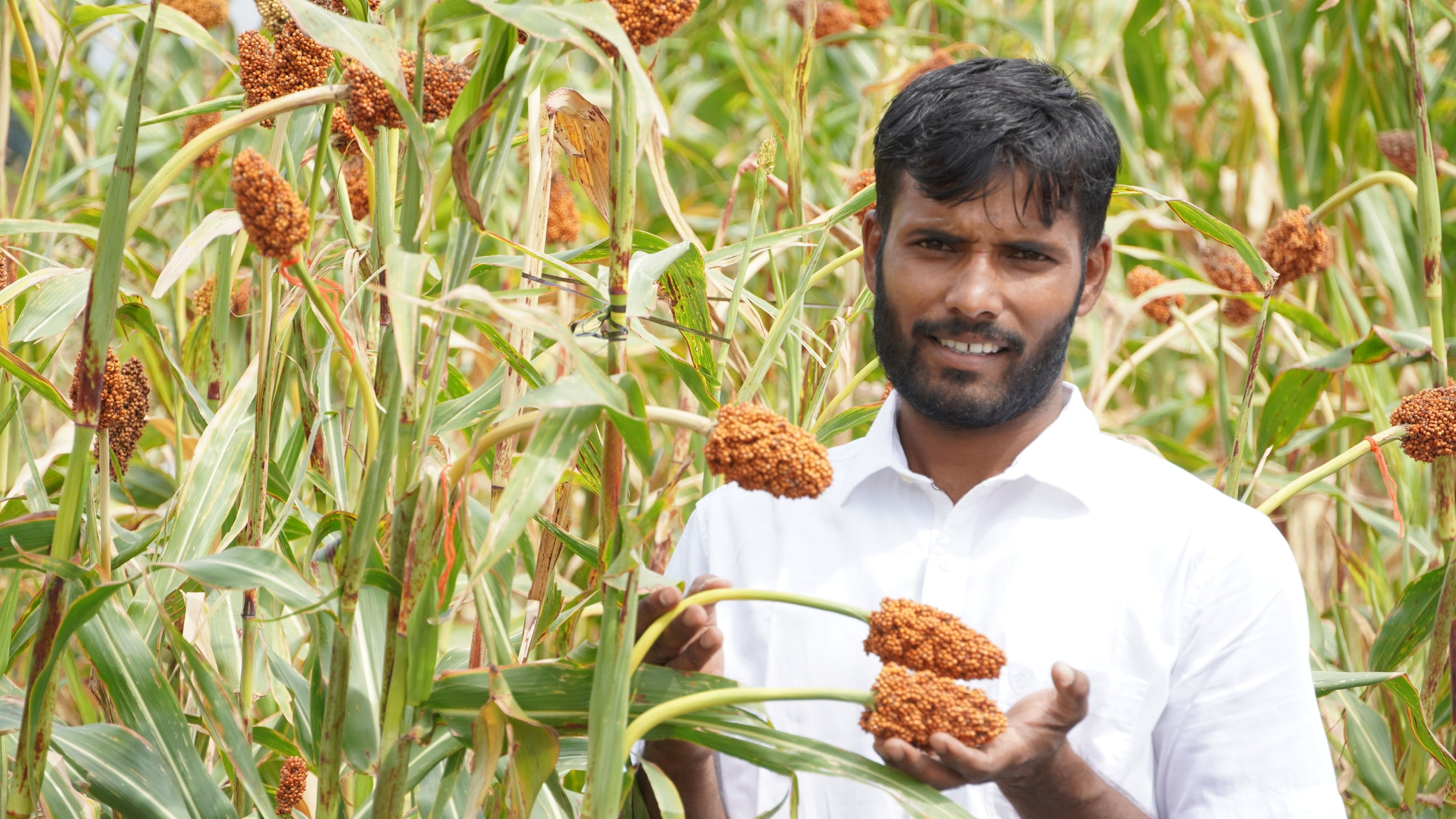
I had seen these jowar varieties long ago, during my childhood, and now I am seeing them here again,” says Hanumantappa, an elderly farmer from Marakumbi village in Belagavi district. “We must at least conserve these indigenous varieties in our fields,” he adds.
Hanumantappa is only one of the many who take delight in looking at the panicles of desi varieties of jowar growing in the fields of Praveen Hebballi, a young farmer from Betasuru village of Savadatti taluk in Belagavi district. He has grown 44 varieties of jowar during the kharif season in one-and-a-half acres of land. The crop is now ready to harvest.
For Praveen, conservation of indigenous varieties involves a lot more than just growing crops. His efforts were instrumental in ensuring that black foxtail millet, once a rare variety, is now available easily to farmers.
He was inspired by the many seed savers in Karnataka. He visited the fields of Shankar Langati and Syed Ghani Khan who have been conserving hundreds of desi paddy varieties. After learning about the techniques of conservation, Praveen started to grow indigenous crops.
Four years ago, he grew 15 varieties of foxtail millets in his field. He selected good-quality seeds and distributed them to interested farmers. For this effort, he was recognised as the ‘Pioneer Millet Farmer’ by the Indian Institute of Millet Research (IIMR), Hyderabad.
Focus on jowar
Like other millets, jowar or sorghum is central to the local cuisine. In fact, jowar is considered the staple food of North Karnataka. Locals, especially those from the farming community, consume jowar in various forms. This crop grows well with less water, and even in barren land.
The cultivation of native varieties of jowar and other grains is a strategy employed by farmers, to adapt to climate change. ‘Sahaja Samrudha’, an organic farmers association, began working with the Revitalising Rainfed Agriculture (RRA) Network, to start a project aimed at cultivating jowar using the rainfed method. When this activity of searching for and conserving rainfed kharif jowar was initiated in Karnataka, Sahaja Samrudha selected Praveen to implement the efforts.
The University of Agricultural Sciences, Dharwad, and the Indian Institute of Millet Research, Hyderabad, offered indigenous varieties of seeds to support the initiative. Farmers from various states also sent seeds.
Due to insufficient rains this kharif season, there was a concern that the crops would dry up. “But surprisingly, the plants grew well and sprouted panicles accordingly. This proves the resilience of indigenous varieties in the context of the climate change crisis,” says Bhagyalaxmi, convenor of RRA Network, who is researching traditional varieties systematically in this area.
Out of 58 varieties, 44 germinated and grew. The characteristics of each variety were unique. Some varieties stood up to 12 feet and others were only four feet in height. The panicles were also appealing to the eye.
Versatility of varieties
G Krishna Prasad, director of Sahaja Samrudha explains the uses of different varieties: ‘Sakkari mukri’ is used to prepare sweet dishes and ‘aralu jola’ is perfect for popcorn. ‘Nandyal jowar’ is well-suited to make dry roti and ‘Jharkhand jowar’ is best for high yields.
Praveen has taken measures to protect the genetic purity of each variety. “Out of 44 varieties, some are long duration crops which have now started yielding, after four months of sowing. Some of the jowar varieties started yielding within two-and-a-half months. Since jowar is predominantly self-pollinated, it should be handled carefully. So, I covered the panicles with paper bags to maintain genetic purity,” Praveen says, explaining his methods of seed conservation.
Recently, a Participatory Varietal Selection workshop was organised at Praveen’s field, where experienced farmers were invited to discuss various issues relating to kharif jowar cultivation. At the end of the workshop, many farmers showed interest in growing jowar and requested seeds.